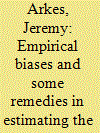|
|
|
Sort Order |
|
|
|
Items / Page
|
|
|
|
|
|
|
| Srl | Item |
| 1 |
ID:
160652


|
|
|
|
|
| Summary/Abstract |
Researchers have, for decades, been attempting to estimate the effects of Selective Reenlistment Bonuses (SRBs) on the probability of reenlistment for the military services. SRBs are targeted to specific military occupations for which reenlistment rates are lower (or expected to be lower) than what is needed. This article first identifies four primary sources of biases affecting these models: reverse causality from supply shifts (a negative bias), the endogeneity of the decision point causing coded SRBs to be higher for reenlisters than leavers (a positive bias), measurement error (a likely negative bias), and excess supply preventing the full effect of an SRB change to materialize (a positive or negative bias). The report proceeds to develop a model that attempts to address the first two biases. With U.S. Navy data from FY2001-FY2008, I examine the extent to which these two biases are affecting the estimated SRB effects. Despite these corrections, the difficulty of addressing the other biases calls into doubt studies that examine the effects of retention bonuses or even the effects of the structure of military pay in general.
|
|
|
|
|
|
|
|
|
|
|
|
|
|
|
|
| 2 |
ID:
129491


|
|
|
|
|
| Publication |
2014.
|
| Summary/Abstract |
This study examines the effects of home-state unemployment rates on attrition behavior of Navy enlistees for successive career windows during the first term of service: the first 6?months, the second 6?months, the second year, and the third year of service. The results indicate that attrition is negatively associated with changes in the local unemployment rate during the first three career windows covering two years of service. However, after two years of service, the estimated effect of the unemployment rate becomes insignificant for most groups of sailors. This is likely because sailors with the poorest job matches are sorted out early in the first term of service.
|
|
|
|
|
|
|
|
|
|
|
|
|
|
|
|
| 3 |
ID:
069887


|
|
|
|
|
| Publication |
Santa Monica, Rand Corporation, 2002.
|
| Description |
xxiv, 98p.
|
| Standard Number |
0833031929
|
|
|
|
|
|
|
|
|
|
|
|
Copies: C:1/I:0,R:0,Q:0
Circulation
| Accession# | Call# | Current Location | Status | Policy | Location |
| 045932 | 355.230973/ASC 045932 | Main | On Shelf | General | |
|
|
|
|
| 4 |
ID:
140259


|
|
|
|
|
| Summary/Abstract |
This paper examines how workplace goals affect the quality of worker output, using data from the recruiting command of the US Navy. Recruiting stations and recruiters are assigned monthly goals for the quantity of new recruits that may create an unintended incentive to sacrifice quality, especially towards the end of the month. Using data on the universe of Navy recruits from FY1998 to 2010, we find significant reductions in the quality of recruits towards the end of the contracting month, both in terms of pre-existing quality of recruits and in medium-term outcomes that reflect the quality of the job match.
|
|
|
|
|
|
|
|
|
|
|
|
|
|
|
|
|
|
|
|
|